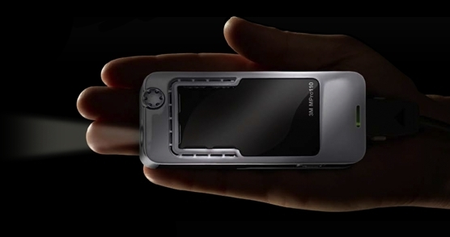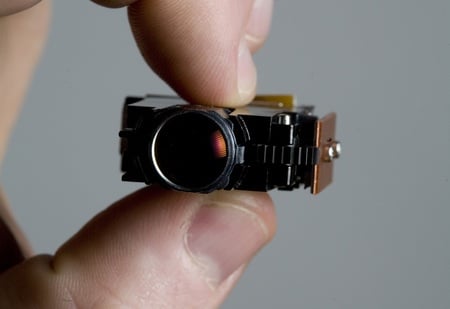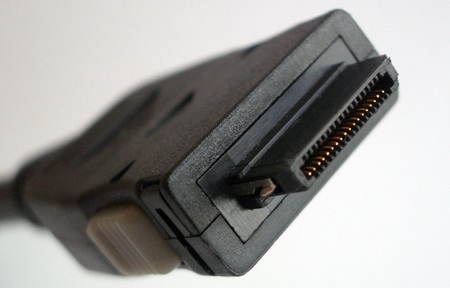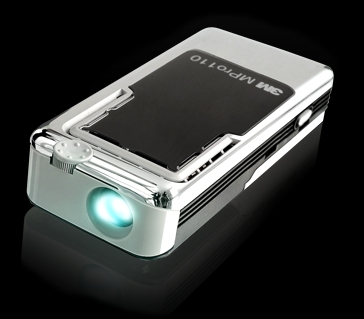Original URL: https://www.theregister.com/2008/11/03/review_projector_3m_mpro110/
3M MPro110 handheld projector
Palm-sized and ready for business
Posted in Personal Tech, 3rd November 2008 09:02 GMT
Review In the spotlight at the Consumer Electronics Show this year was 3M's Mobile Projection Engine, a tiny projector - the vision is that we’ll all have one embedded in our mobile phones etc.
Such products have yet to see the light of day, but the next best thing has: the 3M MPro110 portable projector.
About the size of a chocolate bar and 22mm thick, the 3M MPro110 features both composite-video and VGA inputs. It’s the VGA addition that earns it the ‘Pro’ moniker. The picture comes from a tiny LCoS (liquid crystal on silicon) panel inside the machine.
Sitting comfortably in the hand, it’s reassuringly weighty, with the ribbed metal casing acting as a heat sink, aided by numerous vents in strategic places. The underside has a tripod mount and battery cover, which needs a screw removing to open it up. Given its lithium-ion battery lasts about 50 minutes, a spare seems prudent, but what a hassle if you forget your Philips screwdriver.

3M's MPro110: palm-a-light
With the DC charger input on the right side, the on/off switch on the left and the video inputs at the bottom, the only control function on this device is the focusing wheel at the front. This cog-driven mechanism simply slides the lens backwards and forwards in its enclosure. It seems a little crude in its action but is, nonetheless, effective.
Indeed, you can experiment with the focusing before plugging anything in. Turn it on, the battery indicator LED springs to life and five seconds later the projector kicks in, displaying a 3M logo in its native 640 x 480 resolution. Untethered to a camera or laptop, using it this way, while rather dull, soon gives you an impression of the focusing limitations and ambient light conditions required to get a decent image at the size you’re aiming for.
In a lit office, the MPro110 can present acceptable contrast images at 24in up to 30in in the diagonal. Take the lights down low and the size easily doubles. In complete darkness, a rather soft image of 90in was still a fairly reasonable viewing experience for stills and video. For presentations involving 24-point bold text and large images, this was perfectly adequate, but plain-text tables around 12-point were unreadable with such a large screen projection. These conclusions, as you are about to discover, were the result of hours of painstaking labour.

3M's tiny LcOS-based Mobile Projection Engine
If you’d had not one, but two 3M MPro110’s exhibiting exactly the same problem then, it’s probably fair to say that something is amiss with the design. The issue is to do with its VGA option. Remember folks, this is the ‘Pro’ part of this package and its support for VGA (640 x 480), SVGA (800 x 600), XGA (1024 x 768) and WXGA (1280 x 768) resolutions definitely delivers a discernibly crisper image than the composite input, but only if you can get it to work.
Depending on the mode it is in, the top right of the MPro110’s screen flashes an icon. If the composite lead is attached, then a yellow icon resembling a TV screen flashes. With the VGA option, it’s a white computer. If neither is plugged in, the flashing icon alternates between the two. What you may also see is the computer icon (VGA) with a question mark beneath it. This indicates that the VGA configuration is unsupported. Typically, it’s because refresh rate hasn’t been set to 60Hz. Does the manual tell you all this? Hardly. The manual suggests you’ll see the modes named and makes no reference to these icons, let alone the riddle of the question mark.
Seeing the modes detected is comforting at least. The composite option was a no-brainer and functioned as expected. By contrast, the VGA option was hopeless. When it works, the computer icon flashes momentarily, an hourglass animation shows briefly, the device syncs up and the computer screen appears.

That VGA connector
Both PC and Mac laptops were used for testing and experienced the same problems. On the Mac, the MPro110 appeared as a system display option revealing the available operating resolutions. This would even show when the MPro110 was playing up and not actually projecting the Mac screen, but languishing in its preferred state: useless mode.
The cause of this ongoing condition is almost certainly the 18-pin connector (with 36 contacts) used for the VGA interfacing. With the MPro110’s VGA connector, you have a thick VGA cable with the usual 15-pin D-type at the other end, plus a heavy ferrite bead clamped on the cable just a couple of inches away from this 18-pin pain in the interface. The weight of all this is too much of a strain on the unit’s VGA socket and the connection is both loose and intermittent as a result.
The first unit sent was nigh on impossible to use, because the cable had to be held in some impossible position to get a picture. The second unit involved a similar palaver but, with the aid of a tripod and a few books to support the cable, once a picture had been established it would remain, so long as you didn’t touch it. Focusing had to be done first using the default 3M image.

Shiny, shiny
And so, after hours of sporadic testing, lying down and staring into space was a welcome reward. There Will Be Blood seemed a fitting choice, turning a bedroom into an instant cinema by projecting this onto the ceiling from the VGA port. However, the somewhat muted colours soon revealed the projector’s discolouration of the light grey skies, giving a tobacco-stained vignette to the picture, borne out later by tests with a pure white image.
It’s probably fair to say there are just three types of product: the good, the bad and the frustrating, the latter being a good idea done badly. While the potential is there, the MPro110 just feels like work in progress. One competitor, the Aiptek PocketCinema V10, features internal memory, an SD card slot and movie playback, and seems to deliver on the portable promise. With the 3M MPro110, shortcomings aside, for all the applications its promo video portrays, it’s astounding that some form of storage option wasn't considered.
Verdict
When the shortcomings are taken into account, it seems likely that the MPro 110 should be superseded fairly quickly because, beyond composite-video presentations, its ‘Pro’ pretensions fail to shine.